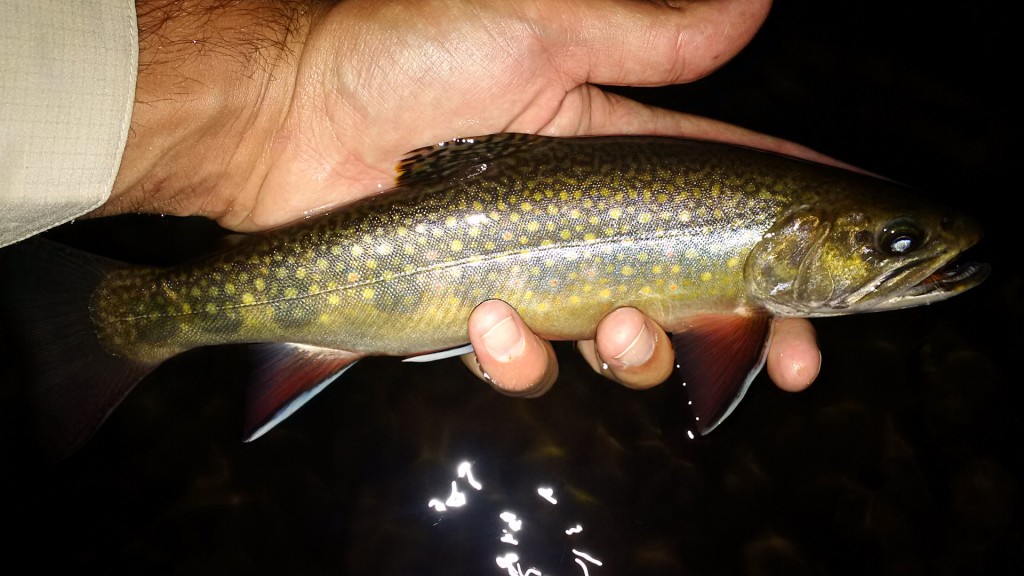September is always a month of mixed feelings for me. It’s easily my favourite time of year to be on the river, with the cooling temperatures, colourful scenery and hungry trout. Unfortunately, it also brings much shorter days and the end of open season for most fly fishing in Ontario.
I spent my Labour Day with a bit of a change in scenery, opting to fish the Brook Trout water above the Cataract on the Credit. I’m usually hesitant to give specifics about where I fish, for good reasons. However, I think in some cases, secrecy and tight lips can lead to lack of awareness about issues. This is water that has been in a state of decline for the last decade or so and only more recently are these issues coming into the foreground. There are definitely still healthy Brook Trout here, but in much smaller numbers and generally in smaller sizes as well, especially at the more easily accessible locations. Catch & Release and barbless hooks are more important than ever here.
I fished a long stretch of this section Monday and caught mostly tiny brookies, in the 4″ range. This is water that, not many years ago, was teeming with brookies in the 8-10″ range, some larger. It wasn’t until I made my way much further downstream, around dusk, that a fairly thick hatch of some (unidentified) large mayflies got things going. I assume the bugs were either Isonychia or Hexagenia atrocaudata (Late Hex). I tied on the largest fly I had in my box, a size #8 Robert’s Drake. I cast it upstream into the corner of a back eddy where a large amount of foam was accumulating and this fish smashed it as it hit the water.
It’s encouraging to know that this water still holds some good sized Brook Trout, probably much larger than the one above (which was easily over 12″). However, it’s still very concerning seeing how much of a decline the water has seen in recent years.
Near the access point, I ran across a very interesting fellow who had entered the river behind me, wearing waders and carrying a milk crate filled with ‘stuff’, but not carrying a fishing rod. It turns out, he was an entomologist by the name of Henry Frania, who was doing some experiments related to the Green Drake disappearances on the Credit River. I recognized the name, as I’ve read some of his papers in the past on this subject. He’s been involved in this research for nearly 10 years and he had a whole bunch of interesting and concerning facts to share.
One obvious bit that stands out to me, which I have said before, is that none of these issues have anything to do with the presence of Brown Trout. There are simply no Brown Trout above the Cataract and there have been upwards of an 80% reduction in fish numbers there, as well as numerous insect disappearances. Wake up MNR… let’s solve the real issues before deciding to remove the Brown Trout and destroy what’s left of this great fishery.


Steve,
I share your concern about the MNR focus on reducing brown trout, to ostensably ‘save’ brook trout…Haven’t fished the stretch you mentioned for about 10 yrs, but agree that with no brown/brook mixing in this section, any decline in brookies (which lets face it are easier to catch than brownies) has to be due to some combination of (i) decline in water quality (ii) habitat degredation (iii) lack of catch n release ethic rather than competition in species..the decline in green drakes is surely symptomatic of (i) and (ii)….
Simon.
PS I did catch an aggressive baby atlantic salmon parr this summer below the cataract.. surely these are bigger threat to brookie population than browns, yet MNR is trying to reintroduce?!
Yeah, the atlantics are another matter altogether. With the amount of marketing and money they dump into that program, I don’t doubt for a second that all of the strategies they are developing (i.e. harvesting of browns) have more to do with the atlantics than the brookies or any other species.
Between the pollution entering the river from Orangeville and other new developments, possibly the nearby dump and warming waters from a combination of weather and lack of stream rehab, there’s enough to focus on. They should try to stabilize and restore conditions before trying to reintroduce native specifies that have been long gone and rely on the cleanest of water conditions (i.e. atlantics).